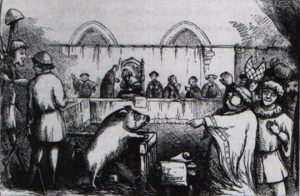pig
 Most people know what the paddy wagon is, and nobody wants to end up in one. An old term for arresting vehicle, the term gets it’s roots from the Irish. Apparently, many of the police officers in early America were of Irish descent. According to Dictionary.com, “Irishman,” 1780, slang, from the pet form of the common Irish proper name Patrick (Irish Padraig). It was in use in black slang by 1946 for any “white person.” Paddy wagon is 1930, perhaps so called because many police officers were Irish. Paddywhack (1881) originally meant “an Irishman.” I suppose that many would look at this slang name for police officer as disrespectful, and they might be right, but no more disrespectful that pig or even cop. Nevertheless, the Paddy Wagon was just a
Most people know what the paddy wagon is, and nobody wants to end up in one. An old term for arresting vehicle, the term gets it’s roots from the Irish. Apparently, many of the police officers in early America were of Irish descent. According to Dictionary.com, “Irishman,” 1780, slang, from the pet form of the common Irish proper name Patrick (Irish Padraig). It was in use in black slang by 1946 for any “white person.” Paddy wagon is 1930, perhaps so called because many police officers were Irish. Paddywhack (1881) originally meant “an Irishman.” I suppose that many would look at this slang name for police officer as disrespectful, and they might be right, but no more disrespectful that pig or even cop. Nevertheless, the Paddy Wagon was just a  vehicle used to transport prisoners to jail. These days, unless it is a big group being arrested at one time, paddy wagons aren’t used much, but they used to be much more common. I’m sure there were many outlaws who knew the inside of a paddy wagon well…at least the ones who were’t very good at their skill. Those who were good at it usually avoided the paddy wagons.
vehicle used to transport prisoners to jail. These days, unless it is a big group being arrested at one time, paddy wagons aren’t used much, but they used to be much more common. I’m sure there were many outlaws who knew the inside of a paddy wagon well…at least the ones who were’t very good at their skill. Those who were good at it usually avoided the paddy wagons.
Back in the Old West, paddy wagons really were wagons, but then so was every other mode of personal transportation, and many forms of business transportation. With the invention of the motorized vehicle, came a different type of Paddy Wagon too. And with the invention of the motorcycle, came an even more unusual type of Paddy Wagon. I  can’t really imagine being taken to jail in a cage attached to a motorcycle, but there were those who were taken that way. This seemed to be common in Los Angeles, which makes sense, because many other places would be too cold for that. Still, imagine being hauled to jail in a cage for all the locals to see. No privacy there. I suppose that would be a special type of punishment for sure, the crime and the embarrassment. Or maybe criminals don’t get embarrassed. I can’t really say. All I know is that if I ever had to be hauled to jail in a Paddy Wagon, I would prefer the type we have today, with no windows.
can’t really imagine being taken to jail in a cage attached to a motorcycle, but there were those who were taken that way. This seemed to be common in Los Angeles, which makes sense, because many other places would be too cold for that. Still, imagine being hauled to jail in a cage for all the locals to see. No privacy there. I suppose that would be a special type of punishment for sure, the crime and the embarrassment. Or maybe criminals don’t get embarrassed. I can’t really say. All I know is that if I ever had to be hauled to jail in a Paddy Wagon, I would prefer the type we have today, with no windows.
 Imagine charging a horse with murder, reckless endangerment, or vandalism for things like bucking its rider off, causing death or injury, or kicking the neighbors fence down. Insane, right…wrong!! For centuries, animals, including insects faced criminal charges across many parts of Europe. Now, I personally think that most insects need to be executed…no trial necessary!! The earliest documented case was a pig, who after being found guilty, was executed at Fontenay-aux-Roses in 1266. At that time it was believed that animals knew right from wrong, like humans do. I don’t think they were far off, because animals do seem to know when they have done something wrong, but I’m not sure that they understand guilt over of an accidental death or injury.
Imagine charging a horse with murder, reckless endangerment, or vandalism for things like bucking its rider off, causing death or injury, or kicking the neighbors fence down. Insane, right…wrong!! For centuries, animals, including insects faced criminal charges across many parts of Europe. Now, I personally think that most insects need to be executed…no trial necessary!! The earliest documented case was a pig, who after being found guilty, was executed at Fontenay-aux-Roses in 1266. At that time it was believed that animals knew right from wrong, like humans do. I don’t think they were far off, because animals do seem to know when they have done something wrong, but I’m not sure that they understand guilt over of an accidental death or injury.

Nevertheless, these trials went on as part of several legal systems until the 18th century. Animal defendants appeared before both church and secular courts, and the charges ranged from murder to criminal damage. Human witnesses were often heard and in Ecclesiastical courts the animals were routinely provided with lawyers. If convicted, the animal was usually executed or exiled. Several books were written about these trials. E.P. Evans’ The Criminal Prosecution and Capital Punishment of Animals, published in 1906, and Sadakat Kadri’s The Trial: Four Thousand Years of Courtroom Drama were two such books. Kadri shows that the trials were part of a broader phenomenon that saw corpses and inanimate objects also face prosecution…which takes weird to a completely new level. Some people think that modern day punishment of children and the mentally ill is rather an echo of those strange earlier rituals.

Several thoughts have come to my mind concerning these animal trials. For instance, animals can’t talk, so how were they supposed to testify or speak in their own defense? Also, were these trials held in a courtroom or a stable…for obvious reasons? And, if the offending animal belonged to someone, not the person who was the victim, how were they compensated for the loss of their animal? After all, they didn’t commit the “crime” that their animal was accused of. This is such a strange practice, that I have to wonder who came up with the idea originally anyway, and were they sane…or more likely insane.

